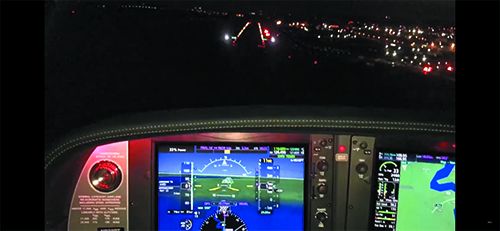We recently showed a piece of B-roll that shows a later-model Garmin Perspective+ equipped Cirrus on a night visual approach with a windshield full of red-over-red VASI and an approaching dark tree line underneath. There are a bunch of things going on in that six-second clip worth talking about, besides its muddy image quality that plays illusions on the dark terrain around the airplane. Just the same, it’s likely the view you’ll have approaching terrain on a dark night—mostly nothing. Link to the video, which focuses on the Cirrus IQ data logging features, at tinyurl.com/yawolh4h.
Leading the way in the night approach footage is Garmin’s visual approach guidance, which is a procedure that’s fetched from the G1000’s FMS and loaded as an approach with vertical guidance. Visual approach procedures became a standard feature in the G1000 NXi and in Garmin’s GTN-series retrofit navigators and if your data is current, you’ll find them in the database. Garmin isn’t alone with the utility. Visual approach procedures are also in the Honeywell Apex avionics in the Pilatus PC-12, and in the FMS databases in plenty of other turbines. It’s compelling automation—the autopilot flies the active procedure as it would an instrument approach, but while it does, your eyeballs need to be outside. Here’s why.
Unlike instrument approaches, supplemental visual approaches are not defined in the system’s navigation database and don’t follow a precise prescribed path. Trees? What trees? Instead, the system calculates the lateral and vertical path for the chosen runway and builds visual approach waypoints based on runway position and course, as the data is written in the navigation database. In the footage, the PFD shows the autopilot flying the vertical portion of the visual approach pretty much on the glideslope, give or take a half-dot deflection in the usual downdrafts coming over the river on final. There’s some camera illusion that makes it appear the airplane is descending to the trees, but it’s not, and it’s we’ll above stall speed and at the sweet spot for the SR22T in landing configuration. The aircraft also has the EVS enhanced vision camera system, and there’s an expanded synthetic terrain profile view on the system’s VSD, or vertical situation display. In the real world and visible out the windshield is a row of diagonal red lights prior to the runway threshold. These lights are on top of a river dike, where the approach crosses on short final. But with Garmin’s glideslope centered, the VASI screams the never-forget warning that when red over red, you’re dead. There’s a reason for this and you have to hit the pilot’s guide to understand it. The study is worth the effort.
I found it in Flight Management section of the Cirrus pilot’s guide, sourced from the Perspective+ Avionics course in the Cirrus training portal. The visual approach procedure broken down, each visual approach will have two transitions—the straight-in (STRGHT) and the Vectors-to-Final (VECTORS). The visual approach waypoints/fixes consist of the initial fix (STRGHT), the final approach fix (FINAL) and the runway approach point (RW–). So here’s why the VASI/PAPI might not agree with the VDI on the PFD. Garmin’s visual approach guidance maps a 3-degree glide path, calculated from the missed approach point up to each waypoint along the extended straight-in path. But the VASI to this approach is 4 degrees, showing reds when the automation says the airplane is on the slope, or at least the one calculated for 3 degrees.
The takeaway is summarized in the release of liability, written pretty matter-of-factly in the pilot’s guide and on the screen when you ask the FMS to load the procedure. The language to live by: For visual approaches, the pilot is responsible for avoiding terrain, obstacles and traffic. And, when a visual approach is selected, the message “Obstacle clearance is not provided for visual approaches” is displayed on the approach selection page. It’s an Enter push to acknowledge before the visual approach is even loaded into the flight plan. Still don’t get it? This is, after all, a visual approach to supplement the eyeballs that have to be outside while you keep the airplane out of the trees, precisely as it was done in the footage. —Larry Anglisano


